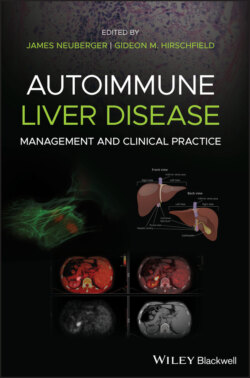Читать книгу Autoimmune Liver Disease - Группа авторов - Страница 33
Cholangiocyte Reaction to Biliary Damage
ОглавлениеBECs are usually quiescent, but following a liver insult they activate and/or proliferate. A typical element of the repair response to liver damage is the ductular reaction (DR), a stereotyped histopathologic lesion of the biliary epithelium that plays a fundamental role in the progression of hepatic fibrosis. The DR is characterized by a marked proliferation of cholangiocytes, leading to formation of reactive ductular cells (RDCs), with poor cytoplasm and arranged in cell cords without a lumen or in richly anastomosed small‐diameter ducts (<10 μm) with almost unrecognizable lumens. RDCs are activated epithelial cells that secrete a vast array of factors, including cytokines, chemokines, growth factors, and angiogenic factors. They may derive from hepatocytes undergoing a process of ductular metaplasia, or from activation of the hepatic progenitor cell compartment and/or from proliferation and dedifferentiation of preexisting cholangiocytes. The increase in RDCs is generally associated with a significant increase in inflammatory infiltrate and portal fibrosis.
RDCs are considered the major driver of portal fibrosis during parenchymal and/or biliary injury. The deposition of fibrosis follows paracrine cross‐talk mediated by the ability of RDCs to secrete profibrotic and proinflammatory growth factors, and cross‐talk with cells of mesenchymal origin, in particular Kupffer cells and portal fibroblasts, which are the main effectors of fibrosis, as stimulators of the deposition of extracellular matrix by activated myofibroblasts. In addition, RDCs also establish paracrine communications with endothelial cells that provide the vascular support necessary for the growth and arborization of the ductal structures themselves [8].
